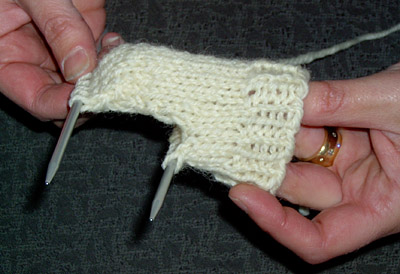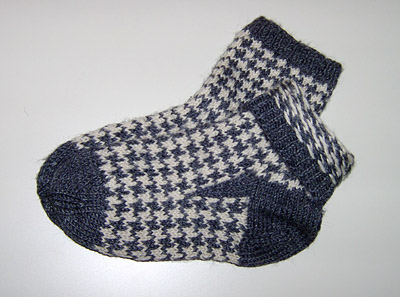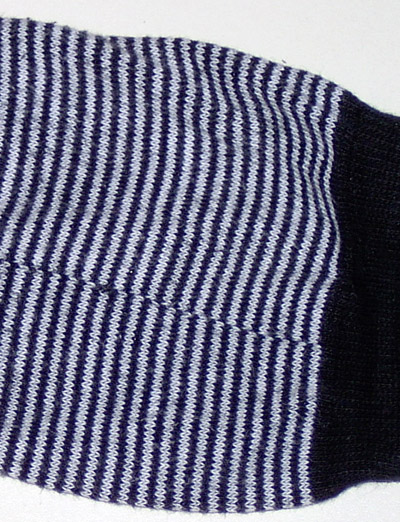Repeat these last
two rows until all the stitches have
been worked. The right side will be
facing. Knit 1 row on all stitches.
For the mathematically inclined, the
number of stitches you have now is
x/6+2, rounded up to an even number.
On your 48-stitch sock, that's 10.
On the 32-stitch sock, that's 8.
5. Shape the Gusset
If you put half
of your stitches on a holder in step
3, return them to a needle. You've
now got the instep stitches on one
needle, and the remaining heel stitches
on a second, with two selvedge edges
between them. You're going to pick
up stitches along those edges to form
the gusset. On each
side, you'll be picking half the number
of heel *stitches you began with --
that is one quarter of the cast-on
stitches.
Knit the stitches
that remain on the heel.
Using a new needle,
pick up the required number of stitches
along the first side, using the loops
created by the slipping in step 2.
This will be referred to as Needle
1.
Using another new needle, knit across
the instep (non-heel) stitches. This
will be referred to as Needle 2.
Using one more
new needle, pick up the required number
of stitches across the other side,
using the loops created by the slipping
in step 2. With this same needle,
knit half of the remaining heel stitches
onto this same needle. This will be
referred to as Needle 3.
You will now have
a small number of stitches left on
your needle, ready to be worked. Slide
these onto Needle 1.

6. Decrease the Gusset
On the very next
round, work a decrease round:
Decrease
Round
Needle 1: Knit to last three
stitches, k2tog, k1
Needle 2: Knit even
Needle 3: K1, SKP, knit to end of
needle
Alternate decrease
rounds and even rounds until you're
back to X, the number of stitches
you cast on originally.
7. Foot
Once you're back
to the original number of stitches,
X, knit until the foot of the sock
measures 2 inches less than
the length of the actual foot that
will be wearing the sock.
8. Decrease for the
toe
Recall that the
center of the round is the center
of the heel. Make sure your stitches
are distributed as follows: 1/4 of
the stitches on Needle 1 starting
at the center of the round, 1/2 of
the stitches on Needle 2 (these are
the stitches for the top of the foot),
and the remaining 1/4 on Needle 3.
Work a Decrease
round:
Needle 1: knit to last 3
stitches, k2tog, k1.
Needle 2: k1, ssk, knit to
last 3 stitches, k2tog, k1.
Needle 3: k1, ssk, knit to
end of needle.
Work an even round.
Alternate decrease rounds and even
rounds until 8 stitches remain.
9. Finish
There as many ways
to finish a sock as there are to make
one. Which method you choose is a
matter of taste, skill and patience.
You can reduce the
toe down to 8 stitches and do a two-needle
bind-off.
Or reduce down to
4 stitches, cut the yarn leaving a
long tail, thread this tail on a yarn
needle and pull the thread through
the 4 stitches, pulling them tight.
Or cast off both
sides and sew them together.
The neat and tidy
prefer grafting, also known as Kitchener
stitch, for a seamless toe.
See Teresa's
excellent article in the Summer
2004 issue of Knitty.
Yarns for Sock Making
Wool and
Blends
Wool is absolutely the best choice
for sock knitting. It's breathable,
comfortable and durable, with a bit
of natural "give" to help
with the fit. It also feels nice running
through your fingers.
Most commercial
sock yarns are a wool and nylon blend,
spun very tightly, and machine washable.
The spin and the nylon add to the
wearability. A non-sock-specific yarn
can be used, but will not wear as
long.
Cotton
Cotton feels and looks great,
but doesn't always have the give or
durability you want for socks. If
you do want to use cotton, choose
a purpose-built sock yarn, like Lang
Jawoll Cotton Superwash or Cascade
Fixation. These are both blends of
cotton with other fibres.
Acrylic and Other Synthetics
Only for kids, and even then,
only if absolutely necessary. Synthetic
yarns don't breathe and the resulting
socks can get very sweaty and smelly.
Synthetics also don't have much flexibility
or give.
The only exception
to this rule is for special effects
yarn. I've seen some marvellous things
done with furry and eyelash yarn used
in the cuff.
Weights
"Proper"
sock yarn gauge is 28 or 30 stitches
across 4 inches/10cm on 2-3mm needles.
If you want to be able to wear your
socks in your everyday shoes, you'll
need to use one of these yarns. Don't
be afraid. It may seem like a lot
of stitches to work to fit around
your foot, but it's still fewer than
the sleeve of the average adult-sized
sweater.
Self-patterning Yarns
Marvellous!
Stripes, Fair-Isle like patterning,
random fun shapes and areas. The ball
band will have a picture of what you
can roughly expect. There are lots
on the market; some popular brands
include Lang Jawoll,
Regia, Fortissima, and Koigu.
Getting Fancy
Ribbing
Alternatives
The ribbing on the
cuff is there for the fit -- to create
stretch to fit around the ankle and
leg. It's entirely flexible. Have
fun with it.
Other ribbing patterns
work nicely: 2x2, 3x3, or odd combinations
like 3x1. Even combinations of ribs
(e.g. 2x2) do have more stretch.
The mock cable rib looks
very sophisticated, and is easy to do. It's
a 4 row repeat, on a multiple of 4 sts.
Round 1:
*p2, skip first st and k into second
stitch, then k into first and slip
both off the needle; repeat from *
Rounds 2-4: *p2, k2; repeat
from * across round

And if you want
a loose, slouchy sock skip the ribbing
entirely. Stockinette stitch will
curl a bit at the top.
Try 3 or 4 rounds
of stockinette stitch before the ribbing,
for a sock with a rolled top that
still stays up.
Pattern stitches
Heel Stitch
A commonly used
stitch pattern for the heel rows (not
the turned part, just the initial
rows of the heel), this provides a
layer of reinforcement.
On right side rows,
slip 1 knit 1 across the row.
On wrong side rows,
slip the first stitch, and purl the
rest.
Body Patterns
Pretty much anything
goes in the body of the sock itself.
The only real guideline is that the
sole should be a simple stockinette
stitch, for comfort.
Combinations of
knit and purl stitches on a stockinette
stitch background create textural
interest. Rounds in reverse stockinette
stitch (that is, purl) provide a striping
effect against a stockinette stitch
background. Try a single round of
purl every 5 or 10 knit rounds for
stripes.
Cable and lace patterns
are both very effective and attractive
in sock designs. Check your favourite
knitting stitch book for ideas. Be
inspired by other knitted garments.
I've seen very effective socks with
basketweave patterns in the cuff and
on the instep. Look up some traditional
gansey patterns -- they're designed
specifically for knitting in the round.
Colour work
Horizontal stripes
are easy -- make them as wide or as
narrow as you'd like. Try irregular
stripe widths for a bit of visual
variety.
Vertical stripes
are just about as simple, and provide
the wonderful side effect of lining
the socks with an extra layer of yarn
for thickness and warmth. To create
vertical stripes in stockinette stitch,
simply work with two different coloured
yarns and alternate the yarns for
every other stitch.
To create vertical
stripes in ribbing, cast on using
two different yarns at the same time,
alternating yarns. Then work k1 p1
ribbing, alternating the yarns in
same order as the cast on. You'll
get the "up" ribs in one
colour, and the "down" ribs
in the other. The ribbing on these
Turkish style socks (a variation of
the pattern in the Socks: Spin-Off
pattern book) is done in two colours.

Fair Isle
Socks lend themselves very well to
Fair Isle style colour work; that
is, using two or more colours at the
same time across the entire row. Fair
Isle typically features small, repeating
motifs or patterns across the row.
Vertical stripes are the simplest
possible form of Fair-Isle colour
work. All Fair Isle knitting has an
extra layer of yarn on the wrong side
(the strands) and creating a warmer
and comfier sock. My favourite pair
of hand-made socks feature a simple
houndstooth pattern, done with a stranded
Fair Isle technique.

In the picture,
I've turned down the cuff of one of
the socks so you can see the stranding.
Intarsia --
colour designs knitted in seperate
blocks, cannot easily be done in the
round. Think of all those sweaters
with ducks or dogs or tractors or
cartoon characters on them. Chances
are, those
designs were knitted flat.
These types of
designs can be done on socks by knitting
them (gasp!) flat, on two needles,
and them sewing them up. Argyle socks
are often created this way. Although
knitting flat is a popular method
for sock knitting, it's not as neat
and requires post-knitting construction
-- the sewing up. Whether you prefer
sewing or knitting in the round is
entirely a personal preference. For
me, the less time spent sewing up
the better. The adventurous are encouraged
to seek out Mary Thomas's description
of "festive knitting", and
Priscilla Gibson-Roberts' incomparable
"Knitting in the Old Way"
for guidance on working colour in
the round.
Problems?
Twisted
stitches
Always stop after you've
completed a couple of rounds of the
cuff and check to see if the knitting
is twisted. Always. There is no fix
for this, so the sooner you check,
the better.
Ladders
You may notice looser stitches
occurring at the break between two
needles -- these are called ladders.
A number of things help fix this problem:
-keeping the two
working needles -- that is, the one
you're knitting stitches from, and
the one you're knitting them onto
-- above the others, and keep the
left needle above the right.
-pulling the yarn
extra tight when working the stitches
at the end and beginning of a needle.
-practice
Too Tight
Cast-on?
Cast on using larger
needles, or cast on over two needles
held together.
Other stretchy cast-on
techniques include the Twisted German,
and Channel Island techniques. Check
your favourite reference book.
The "Jogless
Jog"
When knitting vertical
stripes, you'll notice that something
strange happens at the beginning and
end of the round: the stripes never
line up. This is not unique to hand
knitting. I've got a pair of commercial
knitted socks with narrow stripes,
and the jog is clearly visible.

Meg Swansen developed
an excellent method to disguise the
color jog, described in detail in
an article in Knitters Magazine issue
45, Winter 1996. There's a great summary
and pictures available here.
More Resources
Books
Folk Socks, Nancy Bush, Interweave
Press, 1994
Socks: A Spin-Off Special Publication
for Knitters and Spinners, Interweave
Press, 1994
Vogue Knitting, Pantheon Books
Vogue Knitting On the Go Socks!, Butterick
Publishing Company, 1998
Pattern
Booklets
Stahl Socka Series, Stahl
Wolle
Patons has many booklets with sock
patterns, including:

